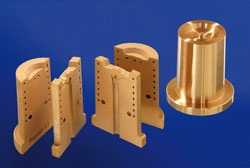Components made from copper powder open up new opportunities

Tool insert with internal cooling channels made of Hovadur (R) K220 produced using the SLM technique. Fraunhofer Institute for Laser Technology ILT, Aachen<br>
Rapid Manufacturing is making triumphant progress in industrial production as it enables digitized design engineering data to be directly and quickly translated into workpieces. In this context, SLM is particularly suitable for producing metal components of complex shapes which cannot be manufactured using conventional technology or can only be produced at very high cost.
In the InnoSurface project, which is funded by the German Federal Ministry of Economics and Technology (BMWi), a research team at Fraunhofer ILT in Aachen has succeeded in modifying the SLM process to make it suitable for copper materials. This opens up new opportunities, for example in the manufacture of tools for plastics processing.
In SLM the workpiece is built up layer by layer on a platform from powder material. Basically, the process functions like a printer working in three dimensions. Directed by the computer-generated design data for the planned workpiece, the metal powder is deposited in layers and then melted at the required points by a laser beam. As a result, it bonds with the already produced part of the object. Material tests have shown that steel or light-metal components produced in this way exhibit the same mechanical properties as conventionally produced parts.
Owing to the high thermal conductivity of copper and copper alloys, however, it has not been possible up to now to use SLM on these materials. Although copper has a lower melting point than steel, it also exhibits lower laser light absorption and higher heat dissipation. As a result, the melting track interupts and tiny balls of molten metal form. This creates cavities and thus reduces the density of the component. »To compensate for the high heat dissipation and the low laser light absorption by the copper during the melting process, we use a 1000-watt laser instead of the 200-watt laser that is currently the norm in SLM,« explains project manager David Becker. To achieve satisfactory results, he chose a laser that produces a particularly even beam profile. Meanwhile Becker and his team modified the entire installation to prevent the high energy input from causing disruptions. For example, they changed the inert gas control system and the mechanical equipment. »Tests with the copper alloy Hovadur K220 are already showing excellent results,« Becker continues, »with workpiece density reaching almost 100 percent.« The technique is therefore ready for industrial use.
It is the high thermal conductivity of copper and its alloys that makes them suitable for many applications. Inserts of these materials in steel injection molding tools for the manufacture of plastic parts ensure rapid heat removal at critical points. SLM makes it possible to integrate conformal cooling channels in these copper inserts to carry a coolant such as water. Cycle times and warping are reduced by fast and even cooling of the entire tool.
In the near future the Aachen-based research scientists intend to go a step further and process not only copper alloys but also pure copper to make dense components. The thermal conductivity of pure copper is almost twice as high as Hovadur K220. This makes for an interesting challenge!
Contacts at Fraunhofer ILT
If you have any questions our experts will be pleased to assist:
David Becker
Rapid Manufacturing
Phone +49 241 8906-568
david.becker@ilt.fraunhofer.de
Dr. Konrad Wissenbach
Additive Manufacturing and Functional Layers
Phone +49 241 8906-147
konrad.wissenbach@ilt.fraunhofer.de
Fraunhofer Institute for Laser Technology ILT
Steinbachstrasse 15
52074 Aachen
Phone +49 241 8906-0
Fax +49 241 8906-121
Media Contact
More Information:
http://www.ilt.fraunhofer.deAll latest news from the category: Process Engineering
This special field revolves around processes for modifying material properties (milling, cooling), composition (filtration, distillation) and type (oxidation, hydration).
Valuable information is available on a broad range of technologies including material separation, laser processes, measuring techniques and robot engineering in addition to testing methods and coating and materials analysis processes.
Newest articles

NASA: Mystery of life’s handedness deepens
The mystery of why life uses molecules with specific orientations has deepened with a NASA-funded discovery that RNA — a key molecule thought to have potentially held the instructions for…

What are the effects of historic lithium mining on water quality?
Study reveals low levels of common contaminants but high levels of other elements in waters associated with an abandoned lithium mine. Lithium ore and mining waste from a historic lithium…

Quantum-inspired design boosts efficiency of heat-to-electricity conversion
Rice engineers take unconventional route to improving thermophotovoltaic systems. Researchers at Rice University have found a new way to improve a key element of thermophotovoltaic (TPV) systems, which convert heat…



